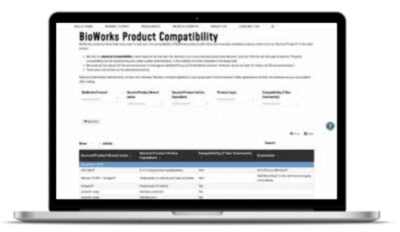Technical Services Newsletter
Foliar Fungal Disease Protection with MilStop® SP
MilStop SP is an OMRI listed foliar fungicide renowned for its ability to eliminate Powdery Mildew upon contact. What sets MilStop SP apart is its unmatched effectiveness against Powdery Mildew and other economically important fungal diseases that affect high-value crops like strawberries, grapes, greenhouse vegetables and leafy greens. The formulation of MilStop SP includes surfactants that improve application coverage and efficacy. As a broad-spectrum preventative and curative fungicide, MilStop SP is one of the most potent solutions available for combating fungal infections. It can also be a great tool when dealing with fungicide resistance. When incorporated into regular spray rotations or tank mixed with our CEASE® fungicide, MilStop SP provides season-long protection by limiting not only the proliferation of Powdery Mildew and Botrytis, but also bacterial pathogens that cause leaf spots. This dynamic combination proves invaluable for effectively managing pathogens within comprehensive disease control programs.
MilStop SP finds application in greenhouse, indoor, nursery, and field production settings. It possesses labels for numerous crops, encompassing annuals, perennials, herbs, vegetables, fruits, nuts, and hemp. It exhibits effectiveness against other foliar diseases such as Monilinia, Alternaria, Penicillium, Anthracnose, Phomopsis, Rust, Cercospora, Scab, Downy Mildew, and Septoria.
In summary, MilStop SP’s organic approval, potent performance against Powdery Mildew, and broad-spectrum control of foliar diseases make it an exceptional choice for combating fungal infections. Its ease of use, residual protection, and compatibility with other disease control solutions contribute to its status as one of the most effective tools in disease management programs.
Here are some notable features and benefits of MilStop SP:
- Broad-spectrum foliar fungicide, approved for use in organic production.
- Preformulated with surfactants, ensuring quick dissolution in water without the need for additional wetting agents.
- Operates at the cellular level, destabilizing and destroying fungi while also modifying pH levels on leaf surfaces to hinder future growth.
- Can be utilized as a standalone fungicide or combined with other foliar disease control solutions.
- Offers residual protection against various foliar diseases, providing coverage for 1 to 2 weeks.
- Dries swiftly and leaves no visible residue.
- Does not impede plant growth.
- 1-hour REI and 0-day PHI
- Very stable formulation with more than 2 years shelf life at 70 – 75 °F (21 – 24 °C)
Maintaining Healthy Trichoderma Levels for Crop Success
Many growers utilize RootShield® PLUS+ for the benefits it provides at planting. But did you know RootShield PLUS+ can be applied multiple times through a crop cycle to ensure root protection and promote plant health?
What is RootShield PLUS+?
RootShield PLUS+ is a proven bio-fungicide that contains two species of Trichoderma (T. harzianum strain T-22 and T. virens strain G-41). These two strains work together to effectively control major root diseases (Cylindrocladium, Fusarium, Pythium, Phytophthora, Rhizoctonia and Thielaviopsis) but they bring so much more.
RootShield PLUS+ has four primary modes of action:
(1) Competitive exclusion: the Trichoderma species outcompete root pathogens for space and resources on the root surface, thus obstructing their access to the roots.
(2) Antagonism: As the Trichoderma grow, they produce enzymes and other metabolites that inhibit pathogen growth.
(3) Induce a plant’s natural defenses
(4) Mycoparasitism: Trichoderma will grow around mycelial strands of pathogens and produce enzymes which disintegrate the invading pathogen’s cell walls.
When RootShield® PLUS+ is applied to growing media, the Trichoderma spores germinate within 16 – 24 hours. The emerging mycelia grow around the plant’s roots, occupying space in the rhizosphere. After 24 hours the Trichoderma cannot be dislodged from the roots. In the growing medium, RootShield can tolerate a wide pH range (4 – 8) and grows at temperatures from 48° to 97° F.
When to apply RootShield® PLUS+ for extended protection?
A RootShield PLUS+ application is effective for approximately 8 to 12 weeks, depending on growing conditions. Over time, due to microbial competition, the Trichoderma concentration slowly declines to levels that are not optimal for root protection. Consequently, we recommend re-application of the biofungicide to maintain levels of Trichoderma in the growing medium.
When crops or liners are transplanted into larger containers, the media should be treated with RootShield PLUS+ WP (6-8 oz per 100 gallons), or the granular formulation can be pre-incorporated into the medium (1.5 lbs/yd3). This ensures that sufficient Trichoderma spores will be available to colonize and protect the new roots as they grow.
If a crop is in its final container size and was treated with RootShield PLUS+ prior, an additional application can be made 8 to 12 weeks later. This can be applied at a half rate (3-4 oz per 100 gallons) to boost Trichoderma levels on the plant’s root system and effectively prevent root disease for an additional 8 to 12 weeks. This re-application interval can be repeated throughout the crop cycle.
Ensuring Success
Despite RootShield’s ability to parasitize pathogenic fungi, it is not considered an eradication or rescue treatment. Its efficacy is greatly enhanced if it is administered early, ideally during propagation and prior to root infection. Applications of RootShield PLUS+ through the production cycle will ensure that adequate levels of Trichoderma are maintained in the growing medium, providing weeks of protection against detrimental soilborne pathogens.
BotryStop® WP: Effective Botrytis management now comes in a new, room temperature-stable formulation
 Botrytis is a rough disease to manage, and growers are left struggling to gain control with conventional fungicides due to fungicide resistance. This has led to a greater emphasis on using cultural and biological methods as the primary defense against this pathogen.
Botrytis is a rough disease to manage, and growers are left struggling to gain control with conventional fungicides due to fungicide resistance. This has led to a greater emphasis on using cultural and biological methods as the primary defense against this pathogen.
To make your life a whole lot easier, we’ve introduced BotryStop WP. This re-formulated biofungicide has improved room-temperature storage, increased ease of use, and remarkable suppression power against Botrytis. BotryStop WP has proven its effectiveness against Botrytis on a variety of crops, indoors and outdoors, such as strawberries, grapes, raspberries, geraniums, and poinsettias. The updated formulation also includes bacterial leaf spot (Xanthomonas spp.) and can be used on a wider range of crops, whether conventional or organically grown.
This novel product is a unique punch for resistance management and a fantastic rotation partner for your IPM strategy. For a closer look into its wonder, take a peek at the BotryStop WP White Paper.
Introducing the BioWorks Product Compatibility Tool
 One useful feature of the BioWorks website is the Product Compatibility Tool. This new interactive tool allows growers and pesticide applicators to efficiently determine whether certainBioWorks products can be tank mixed with other products on the market.
One useful feature of the BioWorks website is the Product Compatibility Tool. This new interactive tool allows growers and pesticide applicators to efficiently determine whether certainBioWorks products can be tank mixed with other products on the market.
Tank mix compatibility is important because it determines whether it is safe to mix two or more pesticides in the same application tank. Incompatible pesticides can react with each other in the tank, causing several problems. Products not compatible could reduce the efficacy of biological pesticides, increase phytotoxicity risk to crops, and produce physical changes to the spray solution. These problems can lead to poor pest control, spray equipment and/or crop damage which could be costly to an operation.
However, tank-mixing compatible pesticides can be beneficial to growers for several reasons:
- IMPROVED PEST CONTROL: Tank mixing pesticides can increase the overall efficacy. Different pesticides have different modes of action, so mixing them can provide more comprehensive control of the pest. This is particularly important when dealing with resistant populations. For example, SuffOil-X® kills on contact through suffocation and Molt-X® is an IGR (Insect Growth Regulator); these two-products tank mixed offer quick knockdown control plus longer residual by interrupting the pest lifecycle.
- COST-EFFECTIVENESS: Tank mixing can also save time and money by reducing the number of application treatments needed. For example, by tank mixing a fungicide (i.e., CEASE®)with an insecticide (i.e., SuffOil-X), growers can achieve control of both disease pathogens and insect pests with a single application, rather than applying them separately.
- BETTER CROP YIELD: By effectively controlling pests and diseases, tank mixing pesticides can also improve crop yield and quality, which can result in better profits for growers.
To use the Product Compatibility Tool, simply select the products you are interested in using from the drop-down menus provided. The tool will then display a list of compatible and incompatible products, as well as any special considerations that may need to be taken into account when using the selected products together.
The BioWorks Product Compatibility Tool is a valuable resource for growers who want to ensure that they are using the most effective and safe combination of products on their crops. It can also help operations save time and money by avoiding the use of incompatible products, which could potentially harm their crops or lead to reduced yields.
The BioWorks Product Compatibility Tool can be found here, or on our Resource Page along with other helpful information on our products.





